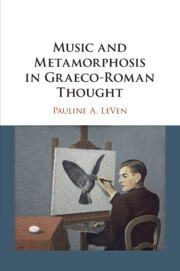Book contents
- Music and Metamorphosis in Graeco-Roman Thought
- Music and Metamorphosis in Graeco-Roman Thought
- Copyright page
- Dedication
- Contents
- Acknowledgments
- Abbreviations
- Introduction
- Chapter 1 Forest: On Surrounds
- Chapter 2 Ringdove: On the Uncanny Power of Performance
- Chapter 3 Cicadas: On the Voice
- Chapter 4 Echo: On Listening
- Chapter 5 Reeds: On Musical Objects
- Chapter 6 Nightingale: On Expression
- Chapter 7 Beetle: On Rhythm
- References
- Citations Index
- Subject Index
Chapter 5 - Reeds: On Musical Objects
Published online by Cambridge University Press: 25 November 2020
- Music and Metamorphosis in Graeco-Roman Thought
- Music and Metamorphosis in Graeco-Roman Thought
- Copyright page
- Dedication
- Contents
- Acknowledgments
- Abbreviations
- Introduction
- Chapter 1 Forest: On Surrounds
- Chapter 2 Ringdove: On the Uncanny Power of Performance
- Chapter 3 Cicadas: On the Voice
- Chapter 4 Echo: On Listening
- Chapter 5 Reeds: On Musical Objects
- Chapter 6 Nightingale: On Expression
- Chapter 7 Beetle: On Rhythm
- References
- Citations Index
- Subject Index
Summary
All Greek musical instruments have aetiological tales associated with their creation, and the syrinx (or panpipes) is no exception. A detailed account of the origins of the musical object appears in three texts: a passage of Ovid’s Metamorphoses (1.689–723), a mythical narrative embedded in Longus’ Daphnis and Chloe (2.34), and the version quoted above from Achilles Tatius’ novel Leucippe and Clitophon. As with the rest of our stories, no link of imitation or subversion between different narrative versions of the myth can be established, since the dates of each of the narratives are so uncertain. All we can say is that the three narratives are similar in their basic scenario, but differ in their details and emphasis. These different narrative versions of the myth constitute elaborate (and sometimes discordant) meditations on aesthetic and ontological issues related to the musical instrument and the experience of listening to its sound.
- Type
- Chapter
- Information
- Music and Metamorphosis in Graeco-Roman Thought , pp. 136 - 167Publisher: Cambridge University PressPrint publication year: 2020

